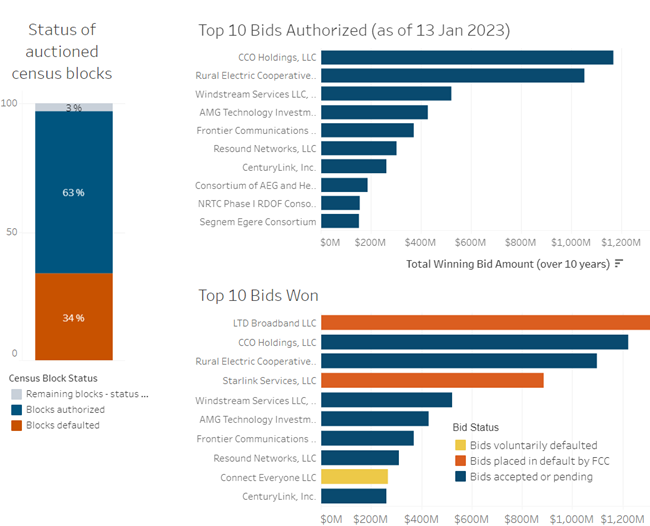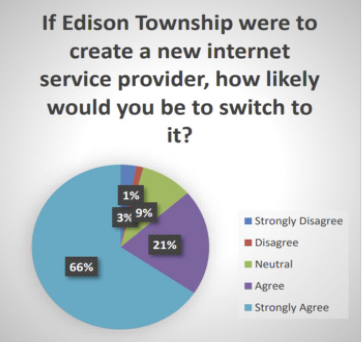
Fast, affordable Internet access for all.

The Rural Digital Opportunity Fund (RDOF) was supposed to drive affordable fiber into vast swaths of long-underserved parts of rural America. And while the FCC administered program accomplished some of that goal, a multitude of problems have plagued the program since its inception, putting both current and future broadband funding opportunities at risk.
The $20.4 billion RDOF program was created in 2019 by the Trump FCC as a way to shore up affordable broadband access in traditionally unserved rural U.S. markets.
The money was to be doled out via reverse auction in several phases, with winners chosen based on having the maximum impact for minimum projected cost.
During phase one of the program, the FCC stated that 180 bidders won $9.2 billion over 10 years to provide broadband to 5.2 million locations across 49 states and the Commonwealth of the Northern Mariana Islands.
But, according to ILSR data, roughly 34 percent of census blocks that won RDOF funding–more than $3 billion in awards – are now in default. All told, 287,322 census blocks were defaulted on by more than 121 providers as of December 2023.

The defaults are only one part of a larger problem: namely that many communities bogged down in RDOF program dysfunction may risk losing out on the historic amount of federal funding to build modern broadband networks (BEAD) made possible by the 2021 bipartisan infrastructure law.
One Big Giant Mess
Edison, New Jersey is proceeding with the construction of an affordable, gigabit-capable fiber network after receiving $2 million cash infusion from state leaders. The resulting network will be built on the back of decades’ worth of local frustration with the high prices, spotty availability, and slow broadband speeds provided by regional monopolies.
The city spent $36,750 on a feasibility study in 2022 to determine the plausibility of building a citywide fiber network. The resulting study by Matrix Design Group found that 87 percent of Edison locals would likely switch to a city-owned and operated fiber network if the option existed.
Edison’s network is in the early stages of planning, and city leaders are only just starting to field competing bids from consulting vendors who’ll then draft a more comprehensive business plan.

In the interim, the city has received $2 million as part of the New Jersey fiscal year 2024 budget to help get the proposal off the ground.
"Access to the Internet is no longer a luxury, it’s a necessity,” State Senator Patrick Diegnan, Assemblyman Robert Karabinchak and Assemblyman Sterley Stanley said of the funding. “We commend Mayor Sam Joshi for making high-speed municipal broadband a priority for Edison."
In a post last year made to social media, Joshi detailed the city’s longstanding frustration with regional telecom monopoly Optimum, owned by French telecom giant Altice.
Last November we noted how New York City had scrapped its longstanding plan to build a promising open access fiber network. Not only did that stark reversal leave many partner ISPs high and dry after years of planning, some local community-run ISPs now say the city is forcing them to remove existing free service to affordable housing developments.
People’s Choice Communications, a small NYC cooperative cobbled together by striking Charter Communications workers, was one of several ISPs left in a lurch by the sudden reversal by the Adams administration.
Adding insult to injury, the ISP is now being told by the city to pull existing service provided for free to marginalized communities in The Bronx.
New York City’s original master plan was poised to be a game changer when it was first introduced back in 2020. The plan not only included a pilot program designed to bring affordable broadband to 450,000 residents of New York City Housing Authority (NYCHA) buildings, but a plan to spend $156 million on a pilot open access fiber network.
The proposal was to showcase the real-world benefits of the open access model, which data suggests results in significantly lower costs and higher quality service thanks to increased competition. If successful, the city would have then considered a bigger $2.1 billion plan to deploy such a network citywide, providing a template for major metropolitan areas nationwide.
New Mayor, Old Playbook
With the election of a new mayor, everything changed.
In 2020, New York City officials unveiled a massive new broadband proposal they promised would dramatically reshape affordable broadband access in the city.
Instead, the program has been steadily and quietly dismantled, replaced by a variety of costly half-measures that critics say don’t solve the actual, underlying cause of expensive, substandard broadband.
The New York City Internet Master Plan was ambitious. The plan featured a pilot program designed to bring affordable broadband to 45,000 residents of New York City Housing Authority (NYCHA) buildings, a major streamlining of broadband deployment bureaucracy, and several initiatives prioritizing subscriber privacy and choice.
At the heart of the proposal was a plan to spend $156 million to create citywide fiber and wireless open access networks in underserved portions of the city that would be open to all competitors. The plan specifically targeted the most underserved parts of the city, given officials estimated it would cost $2.1 billion to deploy such a network city wide.
“The private market has failed to deliver the [I]nternet in a way that works for all New Yorkers,” the plan said, pointing out that 29 percent of city households lacked broadband, and 46 percent of families living below the poverty line lacked service due to high prices.
City officials predicted that their plan to boost competition would create 165,000 new jobs, result in a $49 billion increase in personal income, and create up to $142 billion in incremental gross city product by 2045 – all while delivering faster, more affordable broadband to 1.5 million city residents currently without access.
But elections have consequences.
In June of 2022, new New York City Mayor Eric Adams announced that the city would be “pausing” the entire initiative for “re-evaluation.” Insiders familiar with the decision making process say the pause was more of an abrupt cancellation, leaving planners and network built partners high and dry after several years of careful preparation and planning.
Yavapai County, Arizona is pushing forward with a $20 million plan to shore up broadband access across the region. While dramatically scaled back from a $55 million proposal pushed last year, county leaders are hopeful that the effort still drives significant upgrades across the rugged and predominantly rural desert county.
Last fall, Yavapai County officials announced they would be committing $20 million of the county’s $45.6 million in American Rescue Plan Act (ARPA) funds toward its Broadband Final Mile Initiative, a project spearheaded by the Yavapai County Education Service Agency (YCESA) and designed to bring affordable broadband to every student in Arizona.
The county issued an RFP last October looking for broadband providers willing to use ARPA funding to push symmetrical 100 Megabit per second (Mbps) connections further into rural regions. The expansion was to lean heavily on a 2018 Yavapai County decision to spend $3.7 million on a fiber-optic middle mile network connecting 74 schools and libraries.

“The proposals have been reviewed and contracts have been awarded,” Yavapai County School Superintendent Tim Carter told ILSR in an update. “Cox Communications has been awarded the contract for Black Canyon City and Congress, and Altice USA has been awarded the contract for Mayer, the Beaver Creek area, Cornville, and Paulden.”
Cox and Altice Win Grant Awards
Comcast announced at the end of January that it will be expanding its stock repurchasing program to $10 billion for 2022. It’s a reminder that local governments need to be wary about the huge cable and telephone monopolies stopping by their offices and offering generously to solve the digital divide once and for all, if only we give them more taxpayer money.
Doing so has largely been a failed policy, and does a better job of transforming public tax dollars into private wealth than it does in efficiently extending Internet infrastructure to communities that need it most. With all the federal funding on the horizon, and some states already looking like they’re going to listen to monopoly lobbyists rather than their constituents, cities and states would do well to follow along closely.
Business is Good
Stock buybacks by publicly traded companies like Comcast are a commonly used mechanism to transfer wealth from the cash a firm has on hand to the pockets of its shareholders, while also driving up its value. The program expansion from Comcast announces as clear as day that the company’s top priority isn’t connecting Americans; it’s to return the most money for the least investment for its shareholders.